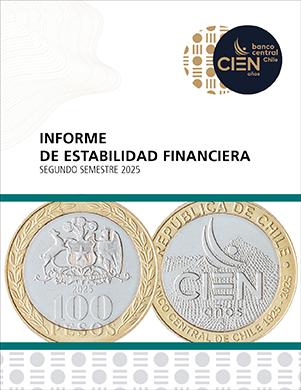FSR
Financial Stability Report Second Half 2025

The main risk to local financial stability continues to be an abrupt tightening of financing conditions due to a deteriorating external environment. Global vulnerabilities have intensified since the last Financial Stability Report (IEF), and geopolitical, trade, fiscal, and institutional risks persist, contrasting with the steady rise in risky financial asset prices. The high valuations of these assets and the high levels of sovereign debt in advanced economies are vulnerabilities that could exacerbate the effects of various risk events on global financing conditions and their pass-through to emerging economies. Locally, financial conditions show a slight improvement compared to the last Report. Credit borrowers’ vulnerability indicators have remained relatively stable, with some improvements for firms that reflect increased sales. The banking system presents capital levels that would allow it to remain solvent in a scenario of severe stress. Although the Chilean economy is not immune to the challenges posed by global variables, it enjoys macroeconomic soundness and robust financial regulation and supervision standards, which provide adjustment mechanisms and buffers to mitigate the effects of adverse shocks.
What does this IEF tell us?

The main risk to local financial stability continues to be an abrupt tightening of financing conditions due to a deterioration in the external scenario.

Global vulnerabilities have increased since the last Report, while pockets of geopolitical, commercial, fiscal, and institutional risk persist, contrasting with a sustained increase in the price of risky financial assets.

The main risk to local financial stability continues to be an abrupt tightening of financing conditions due to a deterioration in the external scenario.
- There are several factors that could reduce investors' risk appetite, generate a global decompression of spreads and trigger a fall in asset prices in international markets.
- These include an intensification of trade, geopolitical or institutional tensions, as well as a more pronounced impact of these elements on activity or inflation, or changes in the perception of the benefits of new technologies that could reduce the valuations of companies in the sector and aggregate growth expectations.

Global vulnerabilities have increased since the last Report, while pockets of geopolitical, commercial, fiscal, and institutional risk persist, contrasting with a sustained increase in the price of risky financial assets.
- In advanced economies, especially in the United States, stock prices, corporate bonds, and other risky assets have continued to rise, reflecting, among other factors, lower risk premiums.
- This, together with a drop in implied volatility indices (VIX, MOVE), accounts for a high level of risk appetite that contrasts with the scenario of high uncertainty associated with commercial, geopolitical and institutional tensions.
- At the same time, global indebtedness, particularly sovereign debt, keeps rising.

Local financial conditions show a slight improvement and the vulnerability indicators of borrowers have remained relatively stable, with some improvements among firms.
- For households, vulnerabilities remain low, similar to what was described in the previous Report.
- Since the previous Report, companies decreased their indicators of indebtedness, debt service ratios and default, reflecting lower financial vulnerability.
- Banks have capital levels that would allow them to remain solvent in a scenario of severe stress.

Although the Chilean economy is not immune to a significant deterioration in the external scenario, it has adjustment mechanisms and headroom to mitigate the effects of adverse shocks.
- At the local level, the materialization of a risk scenario or similar events could trigger capital outflows, increases in interest rates, abrupt corrections in sovereign bond prices, and exchange rate fluctuations that interact with the financial vulnerabilities of local borrowers and lenders.
- The Chilean economy has macroeconomic soundness and robust financial regulation and supervision standards, which allow it to have adjustment mechanisms and headroom to mitigate the effects of adverse shocks.
